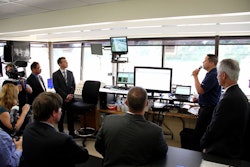There’s a new way of doing business, and it’s being driven by data. Big Data.
Through years of technological innovation, companies amassed vast volumes of information on their business activities—everything from structured production data, marketing, sales, HR, finance, facilities and operations to transaction-level data on suppliers, customers and partners. But the convergence of major technology shifts like cloud computing, mobility and social and business networks sparked a new class of data—texts, tweets, blog posts, Web-based videos and other social postings. And companies that effectively harness this information stand poised to achieve unprecedented levels of productivity and profits.
“Today data analytics confer power to gain advantage in ways hardly imagined a decade ago,” said Zachary Tumin, Special Assistant to the Faculty Chair and Director of Harvard Kennedy School’s Program in Science, Technology and Public Policy. “As never before, you can see and be observed, talk to and be talked about, sense the present and predict the future.”
Tumin is also the author of “Doing Business the Data-Driven Way: Pathways to Success in the Networked Economy,” a report that explores the power of Big Data. Companies that embrace Big Data can ultimately transform their businesses.
Consider the following examples:
- At Cisco, the strategic marketing group mined historic data and social media mentions for customers who revealed both a “propensity to buy,” and a high “readiness to buy.” Cisco’s sales force converted that insight to sales uplift of $4.2 billion.
- EMI Music’s Million Interview database let the company play “Moneyball” Billy Beane-style with music hits, scoring home runs for fans and artists. The result: EMI rises from back-on-its heels to a global music powerhouse.
- Mount Sinai Hospital in New York optimized its patients’ first eight-to-12 hours in the hospital, running hundreds of simulations. With improved utilization, Mount Sinai achieved the financial effect of adding 100 new beds without actually adding one.
Such results aren’t easy to come by. But with increasing frequency, businesses are demanding them.
“Businesses, large and small, want to tap into vast amounts of internally and externally produced information to create competitive insights never possible with the mostly internally focused ERP data that predominates the contents of the corporate data centers today,” said Brian Sommer, Chief Executive Officer of TechVentive, a technology strategy consultancy.
Armed with the right tools, they can. Business networks, for instance, enable companies to discover, connect and collaborate with a global network of partners more efficiently and effectively than ever before.
But networks are about more than just connecting companies, people and processes. Their real power lies in what goes on inside them—all the interactions, transactions and commentary—and the massive amounts of unstructured data that they generate. And as the report findings suggest, it is from this data that the next wave of innovation and business productivity will come.
Market opportunities
Traditional relational or structured data may serve as the foundation for analytic efforts. But by combining it with unstructured information, companies can gain additional insights that enable them to make better business decisions.
In fact, when you combine the convenience and speed of the cloud with the connectivity and intelligence of business networks, you can predict the future with accuracy and recommend the best course of action to capitalize on those predictions.
Consider how consumers already benefit from the convergence of structured and unstructured data:
- Amazon.com harvests the buying patterns (transactions) of its customers to recommend complementary products for up-sale. It also uses community-generated ratings and tips to further guide buying decisions.
- Twitter and Facebook mine unstructured comments to develop psychographic profiles of users and deliver highly targeted advertisements (e.g., promoted Tweets) that have much higher conversion rates than traditional advertising approaches based on demographic segmentation alone.
- The Facebook “Like” button, now so pervasive on Websites ranging from online stores to leading news media outlets to political blogs, offers far more accurate (and quicker) insights into buyer preferences and public opinion than traditional focus groups and straw polls.
- New online and mobile banking options from startups like Square are capitalizing on the convergence of mobile, cloud and social to foster entirely new payment models. Such that enable a consumer to— through their mobile device—use geo-location information, detect when its owner is in his favorite coffee shop, use the cloud to automatically place an order and virtual financial networks to settle out between the customer, the shop’s register and the bank. If the consumer is so inclined, he can include a tip and even post a rating or comment on his visit via integrated social channels.
And through the new “Internet of things,” companies can become more efficient and unleash a host of new data that can be used for everything from social research to targeted marketing to post-sale service. Through leveraging the hundreds of billions of dollars of financial transactions and transactional data along with relationship history that resides in business networks, for instance, buyers and sellers can make more informed decisions by detecting changes in buying patterns or pricing trends and provide confidence and qualifying information on a potential—yet unfamiliar—trading partner.
“Big Data presents an opportunity for companies to run better with new real-time insights via the end-to-end acquisition, acceleration and analysis of one or more Big Data sets,” said Steve Lucas, Executive Vice President & General Manager SAP Analytics, Database & Platform, SAP.
Sommer agreed, confirming that it is through the power of analytics, specifically analytic applications that use both internal and external data, which permits companies to gain insights into product usage; customer consumption data; competitor activity; social sentiment; and more.
“The insights into these kinds of questions give businesses outsized opportunities to widen their profit margins, extend their market share and otherwise disrupt the economic stability and underpinnings of their competitors,” he said.
The multi-lever approach
So how can you get these insights and put them to work for your company?
According to Tumin, there is no single, right approach for managing big data—or harnessing its power. But there are some key strategies for success.
- Have a vision, a non-debatable business goal, around which all can rally. The move to data-driven business is a journey and every journey needs a goal everyone can rally round and aim for. Having one gives you a reason to take that first step together and press on over the inevitable bumps in the road.
- Create a plan that is right-sized for action and gets value in the hands of users fast. You can’t do everything at once. With huge volumes of data potentially available, right-sizing your best next move is especially important.
- Select a platform—a clearing—that can support doing business the data-driven way. Platforms “provide infrastructure and rules that facilitate groups’ transactions and can take many guises,” as referenced by Harvard Business School’s Tom Eisenmann. “Above all, they are trusted, discoverable and usable.”
- Like numbers, data doesn’t lie. It also doesn’t talk. Making the most of big data still requires human intervention. So bring your A-team, know what makes them tick and understand their limitations.
- Manage the politics. Success with data-driven decision-making requires moving the right people toward a non-debatable goal, business-driven, with a feasible plan, well-incented and operating over strong platforms. That takes negotiation and persuasion, the twin arts of political management.
And above all, understand that neither technology nor data are silver bullets and that the move to doing business the data-driven way can be highly disruptive.
“It takes time and persistence to make the transformation,” said Tumin. “But as leading organizations who have made the leap can attest, it’s well worth the effort,” he concluded.
Tim Minahan is Senior Vice President, Network Strategy at Ariba, an SAP Company. For more information on Big Data, download the report at http://bit.ly/11S9VGz.















